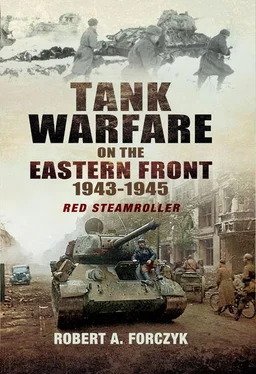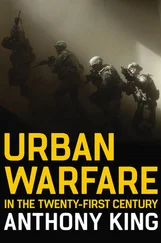Of course, German tanks and other armoured vehicles were evolving rapidly by 1943, based upon two years of combat experience on the Eastern Front. Several painful encounters with the superior Soviet T-34 and KV-1 tanks had caused the Germans to question the value of their existing tanks and to seek a technical solution that would ensure German armoured superiority. The resulting OKH Panzer Commissions of July and October 1941 began the process of defining the requirements for a new medium tank which resulted in the development of the Panther tank in 1942. {9} As 1943 began, the Pz V Panther was about to begin serial production and was expected to re-equip one tank battalion in each Panzer-Divisionen as soon as possible. While the Pz V had far superior gunnery capabilities compared to earlier German models, it was a medium tank in name only and its 44-ton bulk would be far too heavy to cross existing tactical bridges. The Panther was also a fuel-hog that used double the amount of fuel to move 100km compared to a Pz III and, like the 54-ton Tiger, it was difficult to recover on the battlefield. Taken together, the shift to reliance upon heavily-armoured and up-gunned tanks like the Panther and Tiger meant that previous German mobile tactics became impractical; these tanks could not slash cross-country, covering up to 100km in a day, and would have to rely upon shock effect rather than manoeuvre.
The introduction of so many turret-less assault guns and thin-skinned Panzerjäger like the Marder series also caused the Germans to revise their armoured doctrine. In the first two years of combat on the Eastern Front, German medium tanks – often outgunned by the T-34 – had learned to manoeuvre in close and seek the opportunity for flank shots. These aggressive tactics usually succeeded for a number of reasons and often resulted in Soviet positions being overrun. Yet while tanks could still overrun an enemy-held position in 1943, it was usually inadvisable to attempt this with assault guns or Panzerjäger, which were better suited for defensive combat. The real threat was concealed enemy anti-tank guns, which were very difficult to spot from a vehicle like a StuG-III assault gun. Instead, the Germans increasingly began to favour long-range, stand-off engagements so that their assault guns and Panzerjäger would not be put at risk from enemy anti-tank guns or infantry ambushes, but this removed a great deal of the shock effect from German armoured operations.
In the first years of the Second World War, Germany was able to maintain very high standards of training for its Panzertruppen, which gave them an enormous tactical edge over their opponents. However, the edge was beginning to dull as casualties mounted in 1941–42 and the German training system could not keep pace with losses. For example, during the Caucasus Campaign in 1942, the three Panzer-Divisionen (3., 13., 23.) in von Kleist’s 1.Panzerarmee were suffering an average of 600–1,200 casualties per month, including 150–300 killed. {10} Over the course of four months from July–October 1942, this amounted to 3,000 casualties for 3.Panzer-Division, including 600 dead or missing. Throughout 1942, the 23.Panzer-Division suffered a total of 6,569 casualties, including 2,079 dead or missing; 16.8 per cent of these casualties were in Panzer-Regiment 201 (including 331 dead or missing). {11} Although Panzertruppen losses were much lower than the Panzergrenadiers, a much higher proportion of tanker casualties were officers or NCOs. Nor were losses only due to enemy action; in addition to frostbite casualties in the long winter months, diseases such as typhus inflicted significant losses on German Panzertruppen – one Panzer Kompanie in Panzer-Regiment 35 suffered 12 dead from this cause. {12} Approximately two-thirds of all wounded returned to duty with their units. Thus while losses could vary greatly depending upon the operational tempo, the average Panzer-Division on the Eastern Front required something like 400–500 replacement tankers per year in order to keep a 960-man Panzer-Regiment up to authorized strength.
Replacements for the Panzer-Divisionen on the Eastern Front came from the affiliated Panzer-Ersatz-Abteilung in their home Wehrkreis. For example, the 23.Panzer-Division received its Panzertruppen replacements from Panzer-Ersatz-Abteilung 7 in Wehrkreis V (Stuttgart). In theory, a replacement unit like this could train up to about 1,000 new enlisted recruits per year – well above the loss rates on the Eastern Front – but many fewer officers and NCOs. Yet not all recruits passed basic training (some were reassigned to other branches) and even among graduates, not all went to replace combat losses. Obergefreiter Armin Bottger spent two years in a replacement battalion along with a number of his fellow tankers, ferrying tanks to railheads and working at the OKH tank depot at Sagan, before finally going to the front. {13} By mid-war, the Heer had a long logistical tail and replacements were siphoned off to a myriad of other training and non-combat duties. When the 12 Panzer-Abteilungen were destroyed at Stalingrad, thousands of replacements were diverted to rebuild these units – at the expense of the units in the East. Consequently, the front-line Panzer-Regiments on the Eastern Front generally received 1:1 replacements for enlisted tank crewmen, but an insufficient number of junior officers and NCOs.
German Panzer-Ersatz-Abteilungen used obsolete tanks like the Pz I and Pz II for driver training and initial panzer familiarization, but recruits then moved on to obsolescent short-barreled versions of the Pz III and Pz IV tanks for manoeuvre and gunnery training. The Germans made a particular fetish of producing skilled tank drivers, something to which Soviet training attached no great value. During initial basic training, selected recruits could earn a driver permit for tanks up to 10 tons, but required another four weeks of training to earn the permit for tracked vehicles over 10 tons. {14} Experience had shown that a good tank driver had to acquire a good deal of situational awareness in moving across the battlefield, using cover and concealment to avoid enemy observation and to keep the tank oriented toward the direction of threat. A good driver was also capable of making his own tactical selection of route, without being constantly told what to do; in contrast, Soviet tank drivers often expected to be told exactly where and when to move. Nevertheless, both fuel and time allotted for driving training in 1943 were much reduced compared to previous years and, in particular, the rush to get units equipped with Tiger tanks to the Eastern Front led to Tiger crews receiving insufficient driver training at Paderborn, which resulted in numerous accidents at the front. {15}
In 1943, the Heer was forced to shorten basic training for Panzer crewmen from 16 to 12 weeks by introducing a Kurzausbildung (abbreviated training). {16} By this measure, the Heer intended to increase replacement output by one-third. The new training regime placed greatest emphasis on tank gunnery and teaching ‘battle drills’ that prepared a tank crew for combat in conditions that were as realistic as possible. All classroom training was cut to an absolute minimum and recruits were expected to spend most of their time in a field training environment. Most of the inculcation of old-style Prussian military discipline through marching and drill was abandoned. After basic training, the most promising recruits were sent to NCO training for 4–6 weeks and gunners were sent to advanced gunnery training at sites such as the Putlos range. German gunnery training was very advanced and began with training gunners to conduct a proper boresight of the main gun. Usually strings or wire were affixed in a cross pattern across the muzzle and the loader would look through the open breech and visually lay the gun on a target board approximately 800–1,200 metres distant. Then the gunner would adjust the elevation and deflection knobs on his primary sight, to put the gun tube and sight in synch, followed by a zeroing fire with 3–5 rounds. The zero fire confirmed the accuracy of the boresight and enabled final corrections to the gunner’s primary sight. With a good boresight, a tank crew could be reasonably certain that a gunner had a 25–30 per cent chance of hitting a target at the normal combat boresight ranges of 800–1,200 meters. Boresighting and zeroing were key characteristics that distinguished German from Soviet tankers and enabled them to have a much higher probability of achieving hits. However, boresighting and zeroing required discipline and good small unit leadership, since it needed to be conducted soon after any long tactical road march or movement over rough terrain. It is easy, after a night movement in the rain, to put off such details, but it was the kind of detail that made all the difference on the battlefield.
Читать дальше








![John Stieber - Against the Odds - Survival on the Russian Front 1944-1945 [2nd Edition]](/books/405234/john-stieber-against-the-odds-survival-on-the-russian-front-1944-1945-2nd-edition-thumb.webp)



